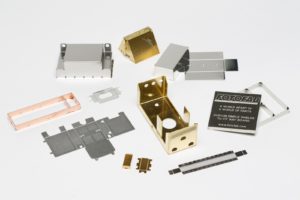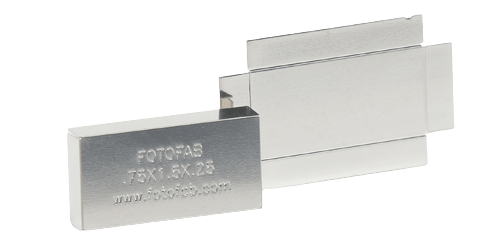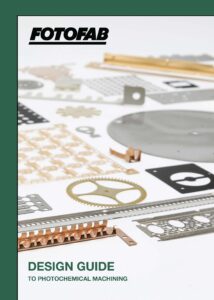EMI & RFI Shielding Materials, Shaping, and Finishing Options
Shielding is essential in electrical engineering to protect electronic devices from electromagnetic interference (EMI) and radio frequency interference (RFI).
EMI and RFI shielding disrupt the proper functioning of devices and can cause unintended operations to occur. Both can also adversely affect the quality and accuracy of your instrumentation signals, cause component failure or malfunction, and/or permanently damage a device. This could lead to catastrophic results in certain applications such as cardiac electronic implants.
The amount of protection a shield provides against EMI and RFI waves depends on the shield’s material, thickness, size of the shielded volume, and frequency of the fields of interest.


EMI and RFI Shielding Design Guide
Fotofab manufactures custom 5-sided and multichannel shielding enclosures for a wide variety of applications that require tight tolerances. Out shielding options for EMI and RFI include low-profile shields and standard RF shields.
We will meet your EMI shielding and RFI shielding needs from the first prototype quantity to the largest production quantities. If your shielding enclosure may eventually be used in several thousand or more quantities, our technical staff can then walk you through our progressive die stamping service as the most cost-efficient way to produce it. They will help determine the best design options for you to consider during the prototyping phase.
Metal EMI and RFI Shielding
Fotofab manufactures RFI and EMI shielding, 5-sided and multichannel enclosures, for attenuating components ranging in operating (and harmonic) frequencies from a few hertz to over 50 GHz.
The type of metal specified may have an impact on an RFI and EMI shield’s performance. In general, shielding against frequencies of 15 MHz or lower is a bulk material effect, and can best be served by employing a ferromagnetic metal such as Steel.
For greater attenuation at these lower frequencies, metals with high permeability and low core losses such as Permalloy 80® or MuMetal® are good candidates.
If the frequencies you are shielding against are greater than 15 MHz, RFI and EMI shielding become less of a bulk material effect and more of a skin (conductivity) effect. At frequencies (and harmonics) of 900 MHz and above, almost any metal including Brass, Nickel Silver, Copper, and Steel, shields similarly assuming a thickness of .002″ (.05 mm) or greater.
Consider specifying a metal alloy called Nickel Silver (55% Copper; 27% Zinc; 18% Nickel; and not a speck of Silver) for RFI shields and EMI shields that are hand soldered or re-flow soldered with flux. In these two soldering environments, Nickel Silver is inherently solderable without any tin or tin/lead post-plating.
Plating like bright tin or tin/lead should be considered with any soldering processes that do not utilize an active solder fluxing agent.
While Fotofab is capable of making RFI and EMI shields in metal thickness from 0.001″ (0.025 mm) to 0.060″ (1.5 mm), the most common metal thicknesses we stock, which offer good shielding and adequate mechanical strength, are 0.006″ (0.15 mm), 0.008″ (0.2 mm), 0.010″ (0.25 mm), 0.012″ (0.3 mm), 0.015″ (0.38 mm), and 0.020″ (0.5 mm).
Bend Channels for EMI and RFI Shielding
Hand-foldable, etched bend channels are one of the unique features that Fotofab can incorporate into your RFI and EMI shielding enclosure. In the common metal thickness listed above, our etched bend channels allow anyone to bend the sidewalls of a shield from a 2D blank to a 3D-finished shield easily, quickly, and precisely. Many of our customers refer to this feature as “metal origami”.
Incorporating our etched bend channel feature can offer you several benefits. First, since your EMI shielding enclosure can be formed without the need for any traditional forming tooling, you can typically save hundreds of dollars in tooling and several days of delivery lead time for your prototype and production needs.
Second, because the etched bend channels exhibit a zero inside radii when formed, you can save space on your board by reducing the clearance necessary between the EMI shielding and the components within it.
Third, although the etched bend channels are typically intended to create 90º right-angle bends, they can also be used to create acute angle bends between 60º and 90º.
Fotofab does not recommend the use of etched bend channels for applications that are load-bearing or encounter extended periods of vibration. The bend channels are created by chemical etching, removing anywhere from 50% to 75% of the original metal thickness, therefore affecting the strength of the metal along these bend channels proportionally.
For EMI and RFI shields that are subjected to loads or extreme vibration, we recommend forming the shield blanks with our traditional forming tools, which will create inside bend radii equal to the metal thickness, at a minimum.
Part Geometry
The economics of Fotofab’s parts are similar to purchasing PCBs, in that you are purchasing the real estate of the part rather than the feature internal to the part. Therefore, features internal to the part, such as mouse-holes for traces, holes for tuning or heat dissipation, identification for your shield or shielded components, and even your company’s logo, are effectively “free”.
And similar to any other custom part from Fotofab, there is no limit to the complexity of your EMI shield’s configuration as long as the dimensions and tolerances are within our capability, as under Dimensional Capabilities.
Since higher RF frequencies radiate through smaller openings than do lower frequency waves, take advantage of our fabrication process to minimize the size of hole features and slots in your EMI shielding design.
Because there isn’t any difference in tooling or part cost for features interior to your part, consider making any mouse holes for traces and any holes for tuning, cleaning, or heat dissipation as small as possible.
We can make slots on EMI shielding as narrow and hole diameters as small as 120% of the metal thickness you select, and we can space them as close together as one times the metal thickness.
If your EMI shielding or RFI shielding design would benefit from being identified with its part number or the component’s part number, or you want your customer to see your logo “engraved” into your product, specify in your print where you would like us to incorporate these features for no additional tooling or part cost, and provide us with a CAD file (.dwg or .dxf format) of your company’s logo.
Removable/Replaceable Covers
Your EMI shielding or RFI shielding design may require that the cover or lid (i.e. the top portion of the enclosure) can be removed so that the components underneath can be tweaked or replaced, and the cover or lid can be resealed. We refer to this design as a “removable lid” shield or a “two-piece” shield.
We are familiar with and capable of making removable lid shields with several different mechanical locking or mating methods. The methods that we are most familiar with include:
- Mating dimples
- Mating tabs and slots
- Friction fits
- Locking spring fingers
Each of these methods is best suited to different shield designs. Please contact our Technical Sales staff to discuss which method(s) best pertains to what you are trying to achieve.

Internal Walls of RFI Shielding
We are very accustomed to making RFI shielding enclosures whose components need to be isolated from one another under a common cover or lid. Similar to the removable/replaceable cover shields, there are several methods for fabricating and assembling internal walls or fences that prevent cross-talk among different regions or components under a larger, universal shield.
We would be glad to discuss the trade-offs of using one universal cover on RFI shielding with one or more internal walls versus designing several individual stand-alone shielding enclosures.
EMI Shielding Raised or Rounded Features
While it’s not as common to see, your EMI shielding design may require a part to have a unique feature such as a stepped or domed region, or a shield with rounded, rather than squared, edges or corners.
With 50 years of shield fabricating experience, Fotofab has the confidence and know-how to help you with all of your metal shielding needs.
EMI & RFI Shielding Forming options
Finally, you will want to let us know how you want to receive your custom EMI or RFI shielding enclosures since we offer different options. We can ship your parts:
- with etched bend channels, tabbed into the metal sheet for your company or designated contract manufacturer to easily detach and form by hand (refer to Bend Channels above),
- with etched bend channels, detached from the metal sheet and formed by Fotofab, ready for final board assembly, or
- without etched bend channels, detached and formed at full metal thickness to the finished part, ready for board attachment.
This shielding design guide is intended to assist you with the most common design issues that we encounter with our customers’ shielding requirements. If you run into issues that are not addressed here, contact one of our Technical Sales staff to discuss and resolve your specific needs.
Fotofab is committed to quality.






Photochemical Etching for EMI and RFI Shields
Fotofab has been chemically etching custom EMI and RFI shielding enclosures for over 50 years in a variety of applications in:
Our photochemical etching process provides tight tolerances needed in printed circuit boards and micro sub-assemblies with low minimums and low tooling costs. For your EMI or RFI shielding enclosures, the following should be considered to ensure that your design is as comprehensive and robust as possible. Contact us for advice beyond the scope of this list.



